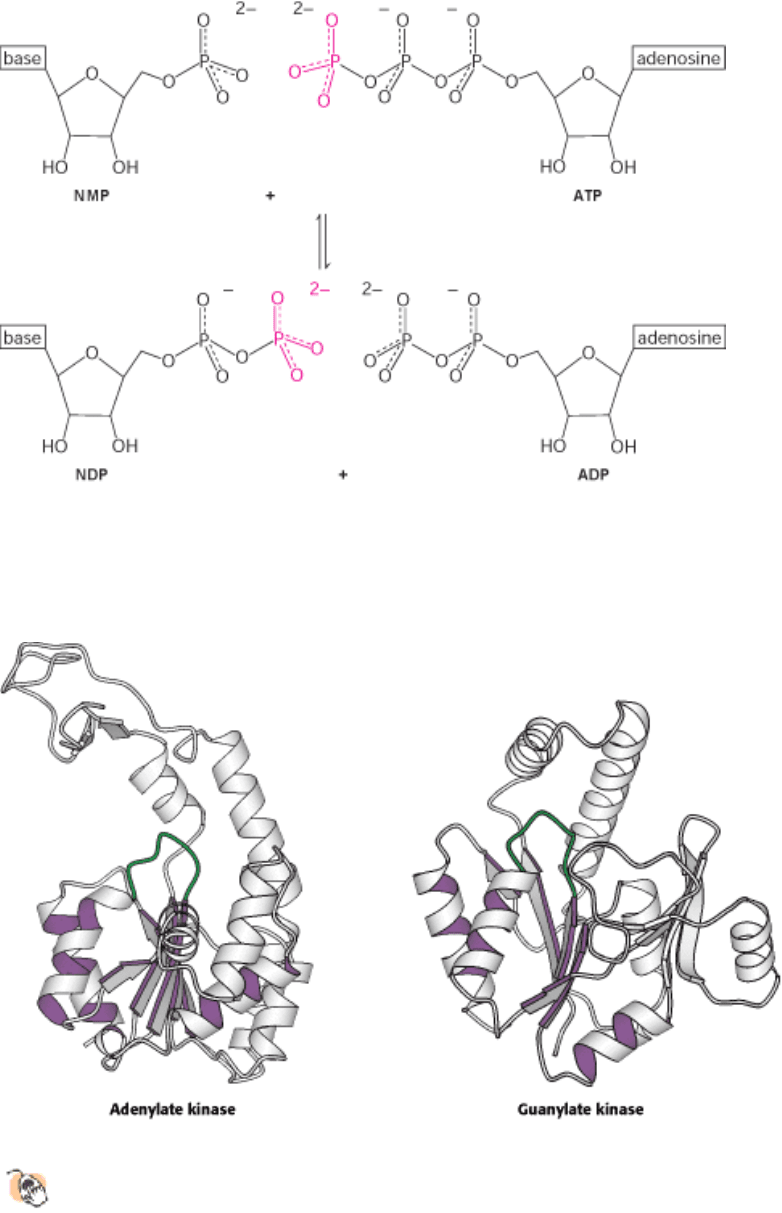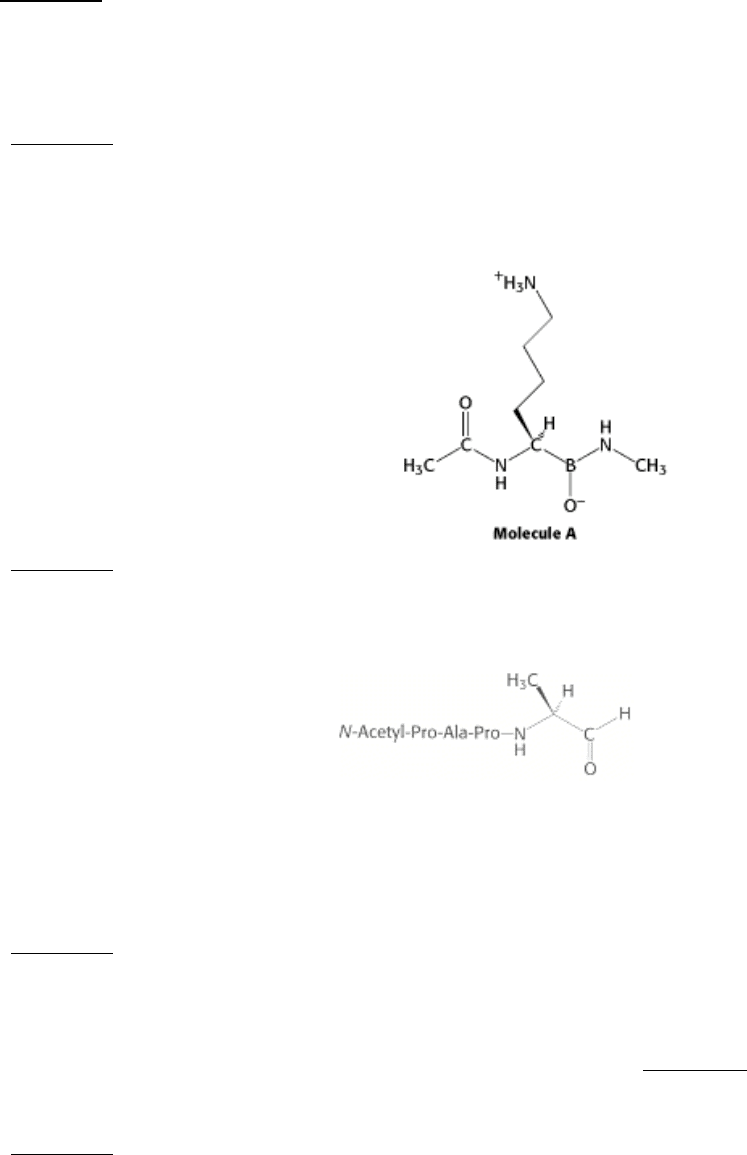Berg J.M., Tymoczko J.L., Stryer L. Biochemistry
Подождите немного. Документ загружается.


I. The Molecular Design of Life 9. Catalytic Strategies 9.4. Nucleoside Monophosphate Kinases: Catalyzing Phosphoryl Group Exchange between Nucleotides Without Promoting Hydrolysis
Figure 9.45. Phosphoryl Group Transfer by Nucleoside Monophosphate Kinases. These enzymes catalyze the
interconversion of a nucleoside triphosphate (here, ATP) and a nucleoside monophosphate (NMP) into two nucleoside
diphosphates by the transfer of a phosphoryl group (shown in red).
I. The Molecular Design of Life 9. Catalytic Strategies 9.4. Nucleoside Monophosphate Kinases: Catalyzing Phosphoryl Group Exchange between Nucleotides Without Promoting Hydrolysis
Figure 9.46. Structures of Adenylate Kinase and Guanylate Kinase.
The nucleoside triphosphate-binding domain is a
common feature in these and other homologous nucleotide kinases. The domain consists of a central β-pleated
sheet surrounded on both sides by α helices (highlighted in purple) as well as a key loop (shown in green).

I. The Molecular Design of Life 9. Catalytic Strategies 9.4. Nucleoside Monophosphate Kinases: Catalyzing Phosphoryl Group Exchange between Nucleotides Without Promoting Hydrolysis
Figure 9.47. The Core Domain of NMP Kinases.
The P-loop is shown in green. The dashed lines represent the
remainder of the protein structure.
I. The Molecular Design of Life 9. Catalytic Strategies 9.4. Nucleoside Monophosphate Kinases: Catalyzing Phosphoryl Group Exchange between Nucleotides Without Promoting Hydrolysis
Figure 9.48. P-Loop Interaction with ATP. The P-loop of adenylate kinase interacts with the phosphoryl groups of
ATP (shown with dark bonds). Hydrogen bonds (green) link ATP to peptide NH groups as well as a lysine residue
conserved among NMP kinases.

I. The Molecular Design of Life 9. Catalytic Strategies 9.4. Nucleoside Monophosphate Kinases: Catalyzing Phosphoryl Group Exchange between Nucleotides Without Promoting Hydrolysis
Figure 9.49. The Structures of Two Isomeric Forms of the ATP-MG
2+
Complex. Other groups coordinated to the
magnesium ion have been omitted for clarity.
I. The Molecular Design of Life 9. Catalytic Strategies 9.4. Nucleoside Monophosphate Kinases: Catalyzing Phosphoryl Group Exchange between Nucleotides Without Promoting Hydrolysis
Figure 9.50. ATP-MG
2+
Complex Bound to Adenylate Kinase. The magnesium ion is bound to the β and γ
phosphoryl groups, and the four water molecules bound to the remaining coordination positions interact with groups on
the enzyme, including a conserved aspartate residue. Other interactions have been omitted for clarity.
I. The Molecular Design of Life 9. Catalytic Strategies 9.4. Nucleoside Monophosphate Kinases: Catalyzing Phosphoryl Group Exchange between Nucleotides Without Promoting Hydrolysis

Figure 9.51. Conformational Changes in Adenylate Kinase.
Large conformational changes are associated with the
binding of ATP by adenylate kinase. The P-loop is shown in green in each structure. The lid domain is highlighted
in yellow.
I. The Molecular Design of Life 9. Catalytic Strategies 9.4. Nucleoside Monophosphate Kinases: Catalyzing Phosphoryl Group Exchange between Nucleotides Without Promoting Hydrolysis

Figure 9.52. Three Proteins Containing P-Loop NTPase Domains.
For the conserved domain, the inner surfaces of
the ribbons are purple and the P-loops are green.
I. The Molecular Design of Life 9. Catalytic Strategies
Summary
Enzymes adopt conformations that are structurally and chemically complementary to the transition states of the reactions
that they catalyze. Sets of interacting amino acid residues make up sites with the special structural and chemical
properties necessary to stabilize the transition state. Enzymes use five basic strategies to form and stabilize the transition
state: (1) the use of binding energy, (2) covalent catalysis, (3) general acid-base catalysis, (4) metal ion catalysis, and (5)
catalysis by approximation. Of the enzymes examined in this chapter, three groups of enzymes catalyze the addition of
water to their substrates but have different requirements for catalytic speed and specificity, and a fourth group of
enzymes must prevent reaction with water.
Proteases: Facilitating a Difficult Reaction
The cleavage of peptide bonds by chymotrypsin is initiated by the attack of a serine residue on the peptide carbonyl
group. The attacking hydroxyl group is activated by interaction with the imidazole group of a histidine residue, which is,
in turn, linked to an aspartate residue. This Ser-His-Asp catalytic triad generates a powerful nucleophile. The product of
this initial reaction is a covalent intermediate formed by the enzyme and an acyl group derived from the bound substrate.
The hydrolysis of this acyl-enzyme intermediate completes the cleavage process. The tetrahedral intermediates for these
reactions have a negative charge on the peptide carbonyl oxygen atom. This negative charge is stabilized by interactions

with peptide NH groups in a region on the enzyme termed the oxyanion hole.
Other proteases employ the same catalytic strategy. Some of these proteases, such as trypsin and elastase, are homologs
of chymotrypsin. In other proteases, such as subtilisin, a very similar catalytic triad has arisen by convergent evolution.
Active-site structures that differ from the catalytic triad are present in a number of other classes of proteases. These
classes employ a range of catalytic strategies but, in each case, a nucleophile is generated that is sufficiently powerful to
attack the peptide carbonyl group. In some enzymes, the nucleophile is derived from a side chain; whereas, in others, an
activated water molecule attacks the peptide carbonyl directly.
Carbonic Anhydrases: Making a Fast Reaction Faster
Carbonic anhydrases catalyze the reaction of water with carbon dioxide to generate carbonic acid. The catalysis can be
extremely fast: molecules of some carbonic anhydrases hydrate carbon dioxide at rates as high as 1 million times per
second. A tightly bound zinc ion is a crucial component of the active sites of these enzymes. Each zinc ion binds a water
molecule and promotes its deprotonation to generate a hydroxide ion at neutral pH. This hydroxide attacks carbon
dioxide to form bicarbonate ion, HCO
3
-
. Because of the physiological roles of carbon dioxide and bicarbonate ions,
speed is of the essence for this enzyme. To overcome limitations imposed by the rate of proton transfer from the zinc-
bound water molecule, the most active carbonic anhydrases have evolved a proton shuttle to transfer protons to a buffer.
Restriction Enzymes: Performing Highly Specific DNA Cleavage Reactions
A high level of substrate specificity is often the key to biological function. Restriction endonucleases that cleave DNA at
specific recognition sequences discriminate between molecules that contain these recognition sequences and those that
do not. Within the enzyme-substrate complex, the DNA substrate is distorted in a manner that generates a magnesium
ion binding site between the enzyme and DNA. The magnesium ion binds and activates a water molecule, which attacks
the phosphodiester backbone.
Some enzymes discriminate between potential substrates by binding them with different affinities. Others may bind
many potential substrates but promote chemical reactions efficiently only on specific molecules. Restriction
endonucleases such as EcoRV endonuclease employ the latter mechanism to achieve levels of discrimination as high as
million-fold. Structural studies reveal that these enzymes may bind nonspecific DNA molecules, but such molecules are
not distorted in a manner that allows magnesium ion binding and, hence, catalysis. Restriction enzymes are prevented
from acting on the DNA of a host cell by the methylation of key sites within their recognition sequences. The added
methyl groups block specific interactions between the enzymes and the DNA such that the distortion necessary for
cleavage does not take place.
Nucleoside Monophosphate Kinases: Catalyzing Phosphoryl Group Exchange Without
Promoting Hydrolysis
Finally, NMP kinases illustrate that induced fit
the alteration of enzyme structure on substrate binding facilitates
phosphoryl transfer between nucleotides rather than to a molecule of water. This class of enzyme displays a structural
motif called the P-loop NTPase domain that is present in a wide array of nucleotide-binding proteins. The closing of the
P-loop over a bound nucleoside triphosphate substrate permits the top domain of the enzyme to form a lid over the bound
nucleotide, positioning the triphosphate near the monophosphate with which it will react, in an example of catalysis by
approximation. These enzymes are dependent on metal ions, but the ions bind to substrate instead of directly to the
enzyme. The binding of the metal ion to the nucleoside triphosphate enhances the specificity of the enzyme-substrate
interactions by holding the nucleotide in a well-defined conformation and providing additional points of interaction, thus
increasing binding energy.
Key Terms

binding energy
induced fit
covalent catalysis
general acid-base catalysis
metal ion catalysis
catalysis by approximation
chemical modification reaction
catalytic triad
oxyanion hole
protease inhibitor
proton shuttle
recognition sequence
restriction-modification system
in-line displacement
horizontal gene transfer
P-loop
I. The Molecular Design of Life 9. Catalytic Strategies
Problems
1.
No burst. Examination of the cleavage of the chromogenic amide substrate, A, by chymotrypsin with the use of
stopped-flow kinetic methods reveals no burst. Why?
See answer

2.
Contributing to your own demise. Consider the subtilisin substrates A and B.
These substrates are cleaved (between Phe and X) by native subtilisin at essentially the same rate. However, the His
64-to-Ala mutant of subtilisin cleaves substrate B more than 1000-fold as rapidly as it cleaves substrate A. Propose
an explanation.
See answer
3.
1 + 1 2. Consider the following argument. In subtilisin, mutation of Ser 221 to Ala results in a 10
6
-fold decrease
in activity. Mutation of His 64 to Ala results in a similar 10
6
-fold decrease. Therefore, simultaneous mutation of Ser
221 to Ala and His 64 to Ala should result in a 10
6
× 10
6
= 10
12
-fold reduction in activity. Is this correct? Why or
why not?
See answer
4.
Adding a charge. In chymotrypsin, a mutant was constructed with Ser 189, which is in the bottom of the substrate
specificity pocket, changed to Asp. What effect would you predict for this Ser 189 Asp 189 mutation?
See answer
5.
Conditional results. In carbonic anhydrase II, mutation of the proton-shuttle residue His 64 to Ala was expected to
result in a decrease in the maximal catalytic rate. However, in buffers such as imidazole with relatively small
molecular components, no rate reduction was observed. In buffers with larger molecular components, significant rate
reductions were observed. Propose an explanation.
See answer
6.
How many sites? A researcher has isolated a restriction endonuclease that cleaves at only one particular 10-base-pair
site. Would this enzyme be useful in protecting cells from viral infections, given that a typical viral genome is
50,000 base pairs long? Explain.
See answer
7.
Is faster better? Restriction endonucleases are, in general, quite slow enzymes with typical turnover numbers of 1 s
-
1
. Suppose that endonucleases were faster with turnover numbers similar to those for carbonic anhydrase (10
6
s
-1
).
Would this increased rate be beneficial to host cells, assuming that the fast enzymes have similar levels of
specificity?
See answer
8.
Adopting a new gene. Suppose that one species of bacteria obtained one gene encoding a restriction endonuclease by
horizontal gene transfer. Would you expect this acquisition to be beneficial?
See answer

9.
Predict the product. Adenylate kinase is treated with adenosine disphosphate (ADP).
(a) What products will be generated?
(b) If the initial concentration of ADP is 1 mM, estimate the concentrations of ADP and the products from part a
after incubation with adenylate kinase for a long time.
See answer
10.
Chelation therapy. Treatment of carbonic anhydrase with high concentrations of the metal chelator EDTA
(ethylenediaminetetraacetic acid) results in the loss of enzyme activity. Propose an explanation.
See answer
11.
Identify the enzyme. Consider the structure of molecule A. Which enzyme discussed in this chapter do you think
molecule A will most effectively inhibit?
See answer
12.
An aldehyde inhibitor. Elastase is specifically inhibited by an aldehyde derivative of one of its substrates:
(a) Which residue in the active site of elastase is most likely to form a covalent bond with this aldehyde?
(b) What type of covalent link would be formed?
See answer
Mechanism Problem
13.
Complete the mechanism. On the basis of the information provided in Figure 9.18, complete the mechanisms for
peptide-bond cleavage by (a) a cysteine protease, (b) an aspartyl protease, and (c) a metalloprotease.
See answer
Media Problems

14.
Now you see it, now you don't. Pre-steady-state experiments using chymotrypsin and a chromogenic substrate
(N-acetyl- l-phenylalanine p-nitrophenyl ester) show a "burst" of product at very short times (Figure 9.4).
The Conceptual Insights module on enzyme kinetics explains this result. What results would you see if the
product detected by the assay was the free N-terminal component of the substrate instead of the C-terminal
component? (Hint: Use the pre-steady-state reaction simulation to simulate the experiment. Select different times
following mixing and observe the amount of each product.).
15.
Seeing is disbelieving. DIPF reacts specifically with serine 195 of chymotrypsin. One hypothesis as to why this is
so might be that serine 195 is unusually exposed on the surface of the protein compared to other serines. After
looking at the Structural Insights module on chymotrypsin, what do you think of this hypothesis?
I. The Molecular Design of Life 9. Catalytic Strategies
Selected Readings
Where to start
R.M. Stroud. 1974. A family of protein-cutting proteins Sci. Am. 231: (1) 74-88. (PubMed)
J. Kraut. 1977. Serine proteases: structure and mechanism of catalysis Annu. Rev. Biochem. 46: 331-358. (PubMed)
S. Lindskog. 1997. Structure and mechanism of carbonic anhydrase Pharmacol. Ther. 74: 1-20. (PubMed)
A. Jeltsch, J. Alves, G. Maass, and A. Pingoud. 1992. On the catalytic mechanism of EcoRI and EcoRV: A detailed
proposal based on biochemical results, structural data and molecular modelling FEBS Lett. 304: 4-8. (PubMed)
H. Yan and M.-D. Tsai. 1999. Nucleoside monophosphate kinases: Structure, mechanism, and substrate specificity Adv.
Enzymol. Relat. Areas Mol. Biol. 73: 103-134. (PubMed)
E. Lolis and G.A. Petsko. 1990. Transition-state analogues in protein crystallography: Probes of the structural source of
enzyme catalysis Annu. Rev. Biochem. 59: 597-630. (PubMed)
Books
Fersht, A., 1999. Structure and Mechanism in Protein Science: A Guide to Enzyme Catalysis and Protein Folding. W. H.
Freeman and Company.
Silverman, R. B., 2000. The Organic Chemistry of Enzyme-Catalyzed Reactions. Academic Press.
Page, M., and Williams, A., 1997. Organic and Bio-organic Mechanisms. Addison Wesley Longman.
Chymotrypsin and other serine proteases
J. Fastrez and A.R. Fersht. 1973. Demonstration of the acyl-enzyme mechanism for the hydrolysis of peptides and
anilides by chymotrypsin Biochemistry 12: 2025-2034. (PubMed)
P.B. Sigler, D.M. Blow, B.W. Matthews, and R. Henderson. 1968. Structure of crystalline-chymotrypsin II: A
preliminary report including a hypothesis for the activation mechanism J. Mol. Biol. 35: 143-164. (PubMed)
A.A. Kossiakoff and S.A. Spencer. 1981. Direct determination of the protonation states of aspartic acid-102 and
histidine-57 in the tetrahedral intermediate of the serine proteases: Neutron structure of trypsin Biochemistry 20: 6462-
6474. (PubMed)
